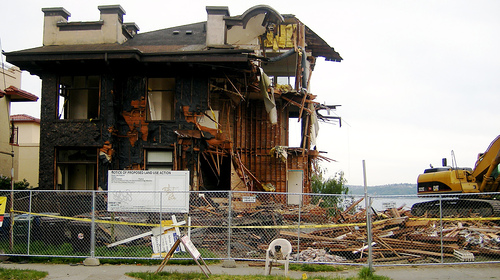A relevant query from Mohamad Tarifi showed up on the Facebook LVT group:

A surprising lesson I learned from helping a family member shop for a house in the US: most property value is in the improvement (building) not the land. For example, in a 1M$ house only 100k-200k is land (and this is south california where land is supposed to be super expensive). Since I am new to all of this can someone please explain to me why this does not significantly weaken the LVT argument?
He doesn’t tell us which part of Southern California this is; nowadays there are plenty of places where land (and houses) are worth little. But even in prosperous times, builders of new houses typically expect the land to cost maybe 20% of the selling price for a new house, so his figure is plausible for some areas. But a new house isn’t the average house.
Routinely, in any dynamic community, houses (as well as other buildings) are demolished from time to time so the land can be re-used. When this happens, it means the land with the house on it was worth less than the bare land. The average house is somewhere along the path from “land value is 20% of total” to “land value is over 100% of total.”
The existing U S personal and corporate income tax cause an additional bias to underestimate land value. The owner of “income property” can deduct an amount from her taxable income based on the “depreciation” of the improvement, but land cannot be depreciated. And, since the U S Government has little idea what the selling price of land actually is, it is a simple matter for the “taxpayer” to overestimate the proportion of real estate purchase price which is for the improvement.
I live in a suburban county just outside of Wash DC. My house was built in 1948.
If you believe the online tax assessment, the land is 55% of the total value.
One thing I don’t quite understand, though, is why it seems that oftentimes/usually the value of the structure is much less than the replacement costs would be.
That 55% might be a realistic assessment. If there are any sales of vacant lots, or of teardowns, in your neighborhood you could look at what they sold for to get some idea of lot value. Could your house be rebuilt for 45% of the total house + lot value? Probably not. But the assessment could be correct, because once we know what the lot is worth, the house can’t be worth any more than the difference between lot value and total lot + house value. And of course, with a teardown, the house is obviously worth zero because the owner wants to tear it down.
One thing that complicates the above a bit is moving of houses, which used to be rather common and is still done occasionally. The lot might be worth more with the house removed, but the structure might have enough value that it would be worth moving to another location.
Of course, when you insure your house against fire or other disaster, you insure it for replacement value, because that’s what it would take to make you whole. I don’t know enough about insurance practice to know whether, if your house burned down, you could just use the proceeds to buy a similar house nearby and sell your now-vacant lot. Seems to me that, in an area of rising real estate prices, you might come out a lot better that way.